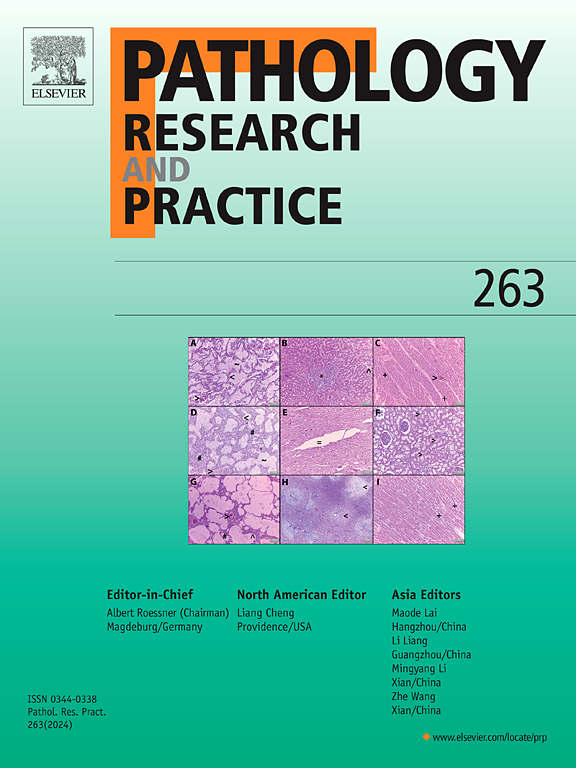The clinicopathological characteristics of co-mutations in exon 2 and 3 of the KRAS gene in patients with colorectal cancer
IF 2.9
4区 医学
Q2 PATHOLOGY
引用次数: 0
Abstract
KRAS, one of the most frequently mutated oncogenes in colorectal cancer (CRC), with mutations in approximately 40 % of all CRC cases. KRAS mutations exhibit considerable diversity. Studies have shown that patients with mutations at codon 13 (G13) of the KRAS gene have a higher risk of mortality, while mutations at codon 12 (G12) of the KRAS gene are also associated with prognosis, though their impact on mortality risk is lower than that of codon 13 mutations. Therefore, identifying the specific KRAS mutation type is crucial for assessing patient prognosis and developing personalized treatment plans. KRAS mutations typically occur in a single exon, whereas co-mutations in exon 2 (G12/G13) and exon 3 (Q61) in a single tissue haven’t been reported yet. In this study, we reported a co-mutation in two exons (exon 2 and exon 3) of the KRAS gene in a 72-year-old male with CRC, adenocarcinoma located at 8 cm from the anus. NGS and ARMS-PCR revealed that two exons of KRAS were co-mutated in this patient-- Q61H in exon 3, with a mutation frequency of 21.09 % and G13D in exon 2, with a variance frequency of 6.06 %. A copy number increase (copy number: 5.65) in MET gene was also found in this patient simultaneously. The clinicopathological characteristics were analyzed, and the possible mechanisms were further discussed. However, due to the CRC patients with co-mutations in two exons of the KRAS are exceedingly rare, a cohort study with more patients’ clinical data is urged.
结直肠癌患者KRAS基因外显子2、3共突变的临床病理特征
KRAS是结直肠癌(CRC)中最常见的突变癌基因之一,在所有CRC病例中约有40% %发生突变。KRAS突变表现出相当大的多样性。研究表明,KRAS基因密码子13 (G13)突变的患者死亡风险较高,KRAS基因密码子12 (G12)突变也与预后相关,但其对死亡风险的影响低于密码子13突变。因此,确定特定的KRAS突变类型对于评估患者预后和制定个性化治疗计划至关重要。KRAS突变通常发生在单个外显子上,而在单个组织中外显子2 (G12/G13)和外显子3 (Q61)的共突变尚未报道。在这项研究中,我们报道了一名72岁男性CRC患者KRAS基因的两个外显子(外显子2和外显子3)的共突变,该患者的腺癌位于距离肛门8 cm处。NGS和ARMS-PCR结果显示,该患者KRAS的两个外显子共突变-外显子Q61H突变频率为21.09 %,外显子G13D突变频率为6.06 %。同时发现MET基因拷贝数增加(拷贝数5.65)。分析其临床病理特点,并进一步探讨其可能的发病机制。然而,由于KRAS两个外显子共突变的CRC患者极为罕见,因此迫切需要有更多患者临床数据的队列研究。
本文章由计算机程序翻译,如有差异,请以英文原文为准。
求助全文
约1分钟内获得全文
求助全文
来源期刊
CiteScore
5.00
自引率
3.60%
发文量
405
审稿时长
24 days
期刊介绍:
Pathology, Research and Practice provides accessible coverage of the most recent developments across the entire field of pathology: Reviews focus on recent progress in pathology, while Comments look at interesting current problems and at hypotheses for future developments in pathology. Original Papers present novel findings on all aspects of general, anatomic and molecular pathology. Rapid Communications inform readers on preliminary findings that may be relevant for further studies and need to be communicated quickly. Teaching Cases look at new aspects or special diagnostic problems of diseases and at case reports relevant for the pathologist''s practice.

 求助内容:
求助内容: 应助结果提醒方式:
应助结果提醒方式:


